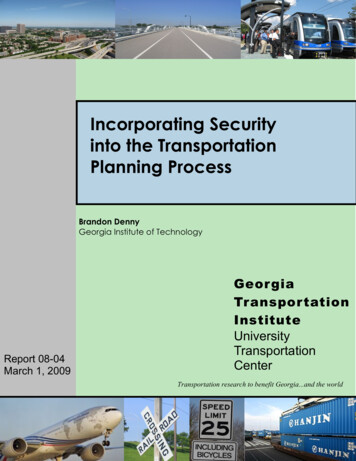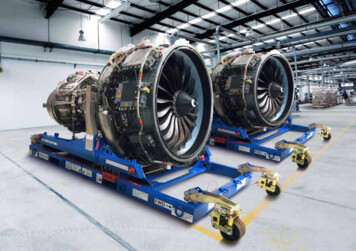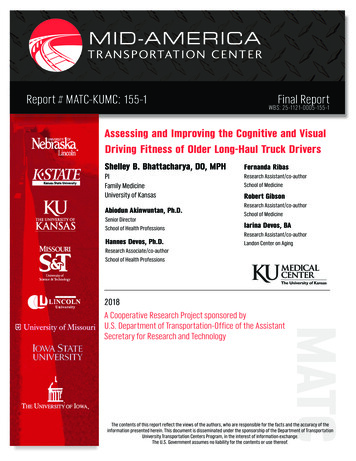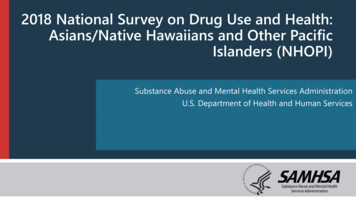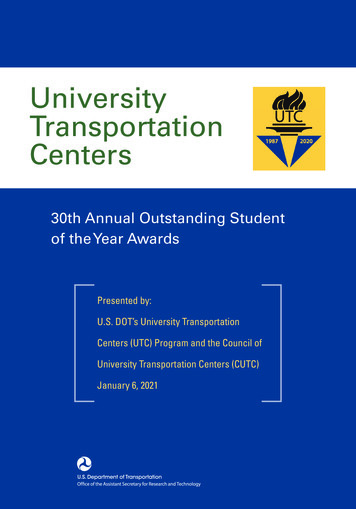
Transcription
UniversityTransportationCenters30th Annual Outstanding Studentof the Year AwardsPresented by:U.S. DOT’s University TransportationCenters (UTC) Program and the Council ofUniversity Transportation Centers (CUTC)January 6, 2021i
ii
WELCOMEWelcome to the 30th Annual University Transportation Centers (UTC) Program’s Outstanding Studentof the Year Awards ceremony, sponsored by the U.S. Department of Transportation (U.S. DOT) andadministered by the Offce of the Assistant Secretary for Research and Technology (OST-R).Each year, at the annual awards banquet of the Council of University Transportation Centers, theU.S. DOT honors outstanding students from participating UTCs for their achievements and promisefor future contributions to the transportation feld. Students of the Year are selected based on theiraccomplishments in such areas as technical merit and research, academic performance, professionalism,and leadership. This booklet provides an insightful overview of their accomplishments and goals.OST-R administers the UTC Program with funding from the Federal Highway Administration.iii
University Transportation Centers ProgramDuring the past few years, the U.S. DOT has launched several new initiatives designed to settransportation in motion toward a more connected, accessible, and sustainable future. Under themanagement of the U.S. DOT’s Offce of the Assistant Secretary for Research and Technology (OST-R),the University Transportation Centers (UTC) Program continues to bolster those efforts throughadvancing research on topics such as connected vehicles, pedestrian and cyclist safety, freightperformance measures, and emissions reduction technologies.Since its beginning, the mission of the UTC Program has focused on the development of advanced U.S.technology and expertise in transportation through education, research, and technology transfer atuniversities nationwide. The UTC Program was created by Section 314 of the Surface Transportation andUniform Relocation Assistance Act of 1987, 49 U.S.C. §5317, with the primary purpose ofconducting research.The Intermodal Surface Transportation Equity Act (ISTEA) of 1991 reauthorized the UTC Programthrough fscal year (FY) 1997, and expanded its mission to include education and technology transfer. Inaddition to the 10 Regional Centers, ISTEA created three “National” Centers and six University ResearchInstitutes at universities named in ISTEA. This expansion led the U.S. DOT to adopt a strategic planningapproach to program management based on a mission and set of goals that applied to all 13 centers andsix institutes. The U.S. DOT extended the grants to the Regional Centers for three years, and announcedits intention to reopen the program to competition, which occurred in 1994.In 1998, the Transportation Equity Act for the 21st Century (TEA-21) reauthorized the UTC Program foran additional six years and increased the total number of centers from the original 10 to 33.In 2005, the Safe, Accountable, Flexible, Effcient Transportation Equity Act: A Legacy for Users(SAFETEA-LU) increased the number of centers to 60. In addition to the 10 Regional Centers, 10 Tier 1funded centers were also competitively selected, and with the exception of the Title III centers, all ofthe UTCs were required to provide a one-for-one funding match.The Surface Transportation Extension Act of 2011 (the Extension Act), gave discretion to redistribute thefunds allocated to specifc research projects and programs designated in SAFETEA-LU. In accordancewith the Extension Act, the U.S. DOT competitively awarded grants to 22 UTCs in the amount ofapproximately 3.5 million each to 10 Tier 1 UTCs, two Tier 1 Transit-Focused UTCs, and 10 RegionalUTCs, and FY 2012 funds were added following extension legislation.1
In 2012, the Moving Ahead for Progress in the 21st Century Act (MAP-21) continued the UTCprogram, authorizing the competitive selection of 35 UTCs to receive a total of 72.5 million infunding for each of FYs 2013 to 2014, with continued funding from extension acts through FY 2015.Following a competition in 2013, grants of approximately 3 million each were awarded to fveNational UTCs, 2.75 million each to 10 Regional UTCs, and 1.5 million each to 20 Tier 1 UTCs.Fixing America’s Surface Transportation (FAST) Act, signed in December 2015, was the frst federallaw in over a decade to provide long-term funding for surface transportation infrastructure planningand investment. The FAST Act authorized 305 billion in spending from FYs 2016 through 2020for the maintenance of existing and establishment of new initiatives in research, education andworkforce development, and the facilitation of technology transfer. To fulfll the FAST Act federalmandate, U.S. DOT hosted a grant competition that resulted in the announcement of 32 new UTCsin December 2016. UTCs in Federal Regions 1, 2, and 3 were added in 2018, and two new NationalCenters focusing on congestion and infrastructure research were added in 2019.The Further Consolidated Appropriations Act, 2020, authorized 5M in funding to establish fournew Tier 1 UTCs with each conducting research in one of the following topic areas:1. Highly Automated Transportation Systems Research2. Communications Technology and E-Commerce Effects on Travel Demand3. Implications of Accessible Automated Vehicles and Mobility Services for Peoplewith Disabilities4. Strategic Implications of Changing Public Transportation Travel TrendsFor more information visit: transportation-centers2
University Transportation CentersOutstanding Students of the YearStudents are organized by primary mode of interest/study area.MARITIMEKaley CollinsUniversity of ArkansasMULTIMODALGabriella Abou-ZeidPortland State University (PSU)Jennifer HallThe University of Texas at AustinAmy LeeUniversity of California, DavisLadan MozaffarianUniversity of Texas at ArlingtonAdam NovotnyVirginia TechNigel PughNorth Carolina Agricultural and Technical State UniversityRachel SeigelUniversity of VermontRydell WalthallThe University of Texas at AustinAmy WymanOregon State UniversityPUBLIC TRANSITCamille BogganUniversity of PennsylvaniaAlex EisenhartSan Jose State UniversityLori PalaioUniversity of South FloridaPrarthana RajaRutgers, The State University of New JerseyAli Rahim-TaleqaniNorth Dakota State University3
ROADRuwa AbuFarsakhLouisiana State UniversityKatherine AsmussenThe University of Texas at AustinBenjamin BauchwitzDuke UniversityMaha ElouniVirginia TechPatrick EmamiUniversity of FloridaSydney JamesUniversity of Nebraska-LincolnTrevor LooneyThe University of OklahomaDaniel McCabeUniversity of WashingtonCadence MotleyUniversity of Nevada at RenoAbdullah Jalal NafakhPurdue UniversityCampbell NeighborgallVirginia TechSamuel RicordUniversity of WashingtonEmiliano RuizThe University of Texas at El PasoTheodore SjursethSouth Dakota State UniversitySamuel SperoniUniversity of California, Los AngelesChristian ViniarskiUniversity of DelawareYan ZhangWashington State University4
Kaley CollinsBioUniversity of ArkansasKaley Collins believes in pushing the limits of what she can achieve; her mottois “I don’t know what ‘can’t’ means.” As a current graduate student in the SteelStructures Research Lab at the University of Arkansas (UArk), she is working tomake critical port structure more reliable through research on modeling combinedstorm surge and wind demands during extreme meteorological events such ashurricanes. While an undergraduate Civil Engineering student, Kaley performedan honors research project characterizing 3-D printed steel material properties.Kaley’s interests and engagement outside of research and academics are broad: Sheparticipated on the University of Arkansas Ranch Horse Team for four years; servedas a UArk Student Ambassador and Honors College Ambassador, and as a member ofthe Academic Integrity Board and the Student Conduct Board, was active in UArk’sChi Epsilon Civil Engineering student service organization, and participated in otherstudent societies.Maritime Transportation Research andEducation Center (MarTREC)Degree and Graduation Date (or Anticipated Date)kec023@uark.eduB.S. in Civil Engineering from the University of Arkansas, May 2020Master’s degree in Civil Engineering from the University of Arkansas, May 2021Preferred Career after GraduationKaley will continue on for a PhD after completing her master’s degree, and sheintends to pursue a career in the private sector.Broad Research Interest AreaInfrastructure systemsSpecifc Research AreaNumerical modeling of materials to determine failure conditions under different loadsPrimary Mode(s)MaritimeTop Accomplishment in 2020In 2020, Kaley was recognized with a National Science Foundation GraduateResearch Fellowship (NSF GRFP) Honorable Mention.Thesis Title and Summary“Port Infrastructure Resilience through Combined Wind-Surge DemandCharacterization”This research seeks to understand the interactive effects of severe wind and stormsurge demands on port infrastructure, and to develop hazard demand models to aidimprovements to infrastructure design resilience.5
Gabriella Abou-ZeidBioGabriella Abou-Zeid holds a B.S. in Sustainable Built Environments from the Universityof Arizona and is currently a second-year Civil Engineering master’s student withtransportation emphasis at Portland State University (PSU). Working in Dr. KellyClifton’s Sustainable Urban Planning and Engineering Research Lab (SUPERLab) at PSU,her interdisciplinary research examines multimodal travel behavior, urban freight, andintersections between transportation and land use. She is the Dwight D. EisenhowerTransportation Fellowship Program’s Top Ranked Masters Fellow for 2019–2020, and a2020 Eno Center for Transportation Future Leaders Development Conference Fellow.Degree and Graduation Date (or Anticipated Date)M.S. in Civil Engineering (Transportation) from Portland State University, June 2021Portland StateUniversityNational Institute of Transportation andCommunitiesGabou2@pdx.eduB.S. in Sustainable Built Environments from the University of Arizona, May 2019Preferred Career after GraduationGabriella intends to pursue a career in academia or the public sector.Broad Research Interest AreaTransportation planning; transport policy; Intelligent Transportation Systems; freightSpecifc Research AreaTransportation, land use, and travel behaviorPrimary Mode(s)MultimodalTop Accomplishment in 2020In addition to being selected as Outstanding Student of the Year by the NationalInstitute for Transportation and Communities (NITC), Gabriella was honored to join theDwight David Eisenhower Transportation Fellowship Program cohort for the second yearin a row.Thesis Title and Summary“Household Provisioning and COVID-19: Transportation Impacts, Technology Adoption,and Barriers to Food Access”Building on a novel dataset of survey responses across fve states, this work examinesthe impacts on shopping trips for food and household items in response to the COVID-19pandemic. Trip-making strategies are explored across land uses, including use of onlineor smartphone-based services to coordinate grocery pickup or delivery. The adoption ofsuch services is likely uneven across demographic groups, given barriers to technologyor differential access to grocery stores. The fndings of this research are critical forfuture emergency planning efforts, and will inform the extent to which changed travelbehavior strategies in response to the pandemic will remain in the recovery period andbeyond.6
Jennifer HallBioAs an undergraduate research assistant to Dr. Randy Machemehl at the Universityof Texas at Austin (UT Austin) in 2017, Jennifer Hall co-authored a report for theCanadian Society for Civil Engineering that compared unsafe cyclist behavior amongthree urban test beds in Austin, TX. This experience motivated Jennifer to pursuegraduate studies in Civil Engineering, specializing in Transportation Engineering,while continuing her research under Dr. Machemehl. She has contributed to teamprojects that have produced a traffc impact analysis, characterization of cyclistbehavior, a parking analysis, and several demand models for off-street bicyclefacilities. Jennifer plans to continue for a PhD.Degree and Graduation Date (or Anticipated Date)The University of Texasat AustinPhD in Civil Engineering from the University of Texas at Austin, May 2022Center for Advanced MultimodalMobility Solutions and Education(CAMMSE) led by the University ofNorth Carolina, CharlotteB.S. in Civil Engineering from the University of Texas at Austin, May 2019Jennyhall381@gmail.comM.S. in Civil Engineering from the University of Texas at Austin, December 2020Preferred Career after GraduationJennifer will be seeking a PhD at UT Austin, and then pursue a career in the public orprivate sector.Broad Research Interest AreaTransportation planning; traffc engineeringSpecifc Research AreaActive transportation; traffc operations; public transportationPrimary Mode(s)MultimodalTop Accomplishment in 2020Jennifer was awarded the Jack and Beverly Randall Endowed Graduate StudentFellowship for Excellence in Civil Engineering. She also was lead researcher inhelping Texas Performing Arts (the UT Austin performing arts center) conduct aparking analysis.Thesis Title and Summary“Forecasting Off-Street Bicycle Facility Demands”This thesis presents three different off-street bicycle demand models. The frst modelis a time series analysis that was created through the collection of cyclist counts; thesecond model predicts the number of cyclists from local sociodemographic data; andthe third model predicts the number of cyclists from local weather data. This thesis isintended to supply city planners with accurate and fexible demand models that canbe applied to any off-street bicycle facility environment.7
Amy LeeBioAmy Lee is a PhD candidate in the Transportation Technology and Policy GraduateGroup at the University of California, Davis (UC Davis). Amy’s research focuses onthe relationships between transportation and land use, particularly the impactsof policy and politics on urban planning, transportation planning, and, ultimately,travel behavior and climate change. Amy has been an instructor and a teachingassistant, and has lectured for courses in the Department of EnvironmentalScience and Policy at UC Davis. Prior to pursuing a PhD, Amy was a researchanalyst on the Modeling and Climate & Energy teams at the Sacramento AreaCouncil of Governments.University of California,DavisDegree and Graduation Date (or Anticipated Date)PhD in Transportation Technology and Policy from UC Davis, 2022M.S. in Transportation Technology and Policy from UC Davis, 2017National Center for SustainableTransportation (NCST)B.S. in Environmental Policy Analysis and Planning from UC Davis, 2011aelee@ucdavis.eduAmy will pursue a career in academia, consulting, or the public sector after receivingher PhD.Preferred Career after GraduationBroad Research Interest AreaTransportation planning, transportation policySpecifc Research AreaTransportation and land usePrimary Mode(s)MultimodalTop Accomplishment in 2020Amy published two peer-reviewed articles, one of which built and showcased theanalytical method that the California Department of Transportation adopted as itsrecommended methodology to evaluate the induced vehicle miles traveled (VMT) ofstate highway expansions.Thesis Title and Summary“Big Structural Change: A Mixed-Methods Investigation into the Policy and Politics ofLand Use and Transportation Infrastructure in California”This dissertation investigates the upstream factors of land use and transportationpolitics and policymaking in California through two streams of inquiry: (1) A study ofthe political coalitions involved in California’s statewide zoning policy, including thebeliefs, ideologies, and interests that unite those coalitions; and (2) A longitudinalanalysis of transportation investments in major metropolitan regions, evaluating ifand how highway investment patterns have changed over the last 20 years and thefactors that have driven change or entrenched the status quo.8
Ladan MozaffarianBioA graduate research assistant at the University of Texas at Arlington Center forTransportation Equity, Decisions, and Dollars (C-TEDD), Ladan Mozaffarian is C-TEDD’slead on GIS, data analysis, and visualization software packages. Her goal is tosynthesize useful fndings on how urban planners and policymakers should react tosocial and environmental change. With a background in architecture and landscapearchitecture, Ladan is interested in knowing how cities will shape, and be shapedby, their human inhabitants. In that vein, she seeks to understand and document theeconomic, social, and environmental impacts of the relationship between humans andthe built and natural environments.Degree and Graduation Date (or Anticipated Date)University of Texas atArlingtonCenter for Transportation Equity,Decisions, and Dollars (CTEDD)ladan.mozaffarian@uta.eduPhD in Urban Planning and Public Policy from the University of Texas at Arlington,December 2023Master of Landscape Architecture from Shahid Beheshti University (SBU), Jan. 2012Bachelor of Architecture from Shahid Beheshti University (SBU), August 2009Preferred Career after GraduationLadan will seek a career in academia.Broad Research Interest AreaTransportation planning; transport policy; Intelligent Transportation SystemsSpecifc Research AreaThe intersection of innovation, equity, and transportation policy in citiesPrimary Mode(s)MultimodalTop Accomplishment in 2020Ladan had two papers accepted by the Transportation Research Record (TRR) and theJournal of Urban Sustainability.Thesis Title and Summary“The Role of Built Environment Attributes and Transportation in EnhancingInnovation and Productivity in Urban Areas”The role of built-environment attributes and other environmental factors inpromoting innovation has rarely been discussed in previous studies. Additionally,there is no comprehensive measure of innovation friendliness for urban areas.The frst objective of this research is to develop a methodological framework thatcomprehensively and objectively measures innovation’s environmental detriments.As a second research objective, this study seeks to ascertain the positive andnegative social and environmental impacts of innovation districts/clusters ofinnovation within cities.9
Adam NovotnyBioAdam Novotny is a third-year PhD student in the Virginia Tech—Wake ForestUniversity Biomedical Engineering and Sciences program, working under Dr. ZacharyDoerzaph in the Center for Advanced Automotive Research at the Virginia TechTransportation Institute (VTTI). He has worked on several projects, studying humanfactors, injury biomechanics, connected and automated vehicle technology, andvehicle safety system development. Currently, Adam is leading a study of e-scootersafety injury reports and system design for one of the leading micromobilitycompanies in the United States.Degree and Graduation Date (or Anticipated Date)PhD in Biomedical Engineering from Virginia Tech, May 2022Virginia TechB.S. in Mechanical Engineering from The College of New Jersey, May 2018Safety through Disruption (Safe-D)Preferred Career after Graduationanovotny@vtti.vt.eduAdam is seeking a career in the public sector.Broad Research Interest AreaTransport policySpecifc Research AreaHuman factors and biomechanics in advanced vehicle safety systems; automatedand connected vehicle technology developmentPrimary Mode(s)MultimodalTop Accomplishment in 2020Adam was frst author on a soon-to-be published-paper titled “Concept Developmentof the Novel Pre Rear-End Positioning and Risk Extenuation System (PREPARES).” In2019, his team won the international title with this project in the Collegiate StudentSafety Technology Design Competition (SSTDC) of the Enhanced Safety of Vehicles(ESV) 26th International Technical Conference.Thesis Title and Summary“E-Scooter Safety Improvements through Design and Training”This project seeks insight into the nature, frequency, and severity of injuries resultingfrom e-scooter crashes, and, using a variety data collection methods, to identify themajor factors contributing to crashes and injuries. The results will inform the designof countermeasures to be incorporated into a revised prototype e-scooter designintended to induce safer riding behavior. Prototype testing through simulation, lab, orfeld evaluation will be performed to assess the updated design’s performance andpotential safety benefts. The results will also be used to develop improved trainingmaterials and methods for inexperienced riders.10
Nigel PughBioNigel Pugh is a PhD candidate in Computational Science and Engineering at NorthCarolina A&T State University after earning simultaneous bachelor’s degrees inComputer Science and Mathematics from Elizabeth City State University. Nigel’scurrent research primarily focuses on dynamic path planning and artifcial intelligence(AI)-based decision making under uncertainty. In summer 2020, he interned withNASA’s Jet Propulsion Laboratory, applying his skillset to the optimal multi-stageroute planning for space vehicles. Nigel has worked on a variety of researchprojects, on topics including emergency evacuation path planning, airport congestionmitigation, traffc speed prediction, and secondary incident prediction.Degree and Graduation Date (or Anticipated Date)North CarolinaAgricultural andTechnical StateUniversityPhD in Computational Science and Engineering from North Carolina A&T StateUniversity, December 2021Bachelor’s degrees in Computer Science and Mathematics from Elizabeth City StateUniversity, 2017Preferred Career after GraduationCenter for Advanced TransportationMobility (CATM)Nigel will pursue a career in the public and/or private sectors after receiving hisdoctorate.nrpugh@aggies.ncat.eduBroad Research Interest AreaTransportation planning; Intelligent Transportation SystemsSpecifc Research AreaEmergency planning, emergency evacuations, and safetyPrimary Mode(s)MultimodalTop Accomplishment in 2020Nigel was the corresponding author on a paper titled “Deep Adaptive Learning forSafe and Effcient Navigation of Pedestrian Dynamics,” which is currently underreview for publication by the journal IET Intelligent Transport Systems.Thesis Title and Summary“AI-Based Decision Making in Human-In-the-Loop”This research develops an optimal navigation model providing more navigationguidance for evacuation emergencies to minimize total evacuation time whileconsidering the infuence of other passengers, based on the social-force model.Nigel will expand this current framework to incorporate decision making in partiallyobservable emergency environments and develop a multi-agent modeling frameworkin emergency evacuation scenarios.11
Rachel SeigelBioRachel Siegel is deeply interested in the growing problem of increasingly frequentextreme precipitation events in the northeast U.S. In order to acquire the training andcredentials to prepare her technically for work in this area, she entered the master’sdegree program in Civil and Environmental Engineering at the University of Vermontin June 2019 after working in the feld.Degree and Graduation Date (or Anticipated Date)M.S. in Civil and Environmental Engineering from the University of Vermont,May 2021B.S. in Environmental Studies from the University of Vermont, May 2016University of VermontTransportation Infrastructure DurabilityCenter (TDIC) led by the University ofMainerseigel@uvm.eduPreferred Career after GraduationRachel wants to work on food modeling or observation, performing risk analysis forareas under threat of food events.Broad Research Interest AreaTransportation planning; infrastructure systemsSpecifc Research AreaModeling bridge-stream network interactions under transient conditions, andevaluating these interactions to frame bridge risk assessments and food mitigationPrimary Mode(s)MultimodalTop Accomplishment in 2020Rachel completed all simulations for the Mad River HEC-RAS model.Thesis Title and Summary“Bridge-Stream Network Analysis across Multiple Sites to Identify Sensitive Structuraland Hydraulic Parameters for Flood Risk Assessment and Floodplain Reconnection”The northeastern United States is experiencing more frequent and extremeprecipitation events of longer duration. Infrastructure must now be able to withstandmore frequent major food events. Satisfying the rigorous hydraulic demands ofthese foods on all bridges and structures is infeasible, so prioritizing resourcesto minimize food damage is critical. This thesis attempts to quantify the dynamicinteractions between a river and its surrounding infrastructure (particularly bridges)under highly uncertain, transient conditions. The purpose is to help assess a numberof food mitigation strategies, such as widening bridges, lowering approaches, andadding culverts. The analysis uses two-dimensional HEC-RAS models, developed forthree Vermont river corridors with varying features. Multiple model simulations areperformed over 25- to 500-year food events. The analysis results are compared andcontrasted across the three study sites to develop a framework for assessing foodmitigation of a bridge-stream network.12
Rydell WalthallBioRydell Walthall specializes in transportation economics and policy, and has workedon projects for the Texas and U.S. Departments of Transportation, the city ofAustin, and the North Central Texas Council of Governments. Rydell has internedat the American Society of Civil Engineers, and taken leadership roles in studentorganizations such as the student chapter of the Institute of Transportation Engineersand University Democrats.Degree and Graduation Date (or Anticipated Date)PhD in Civil Engineering from the University of Texas at Austin, spring 2022The University of Texasat AustinCooperative Mobility for CompetitiveMegaregions (CM2)rwalthall@utexas.eduDual M.P.Aff. in Public Affairs and M.S.E. in Civil Engineering from the University ofTexas at Austin, December 2019B.S. in Civil Engineering from the University of Texas at Austin, December 2013Preferred Career after GraduationRydell is seeking a career in the public sector.Broad Research Interest AreaTransport policySpecifc Research AreaTransportation economics and policyPrimary Mode(s)MultimodalTop Accomplishment in 2020Rydell completed a thesis in fulfllment of the requirements for dual master’s degreesin Public Affairs and Civil Engineering.Thesis Title and Summary“Rail Electrifcation’s Potential for Emissions Abatement in the Freight Industry: ACase Study of a Transcontinental Rail Corridor”This research examines freight rail electrifcation by creating an energy model tosimulate trains along specifc corridors. The parameters for the energy model weredeveloped after an extensive literature review. Using publicly available data sources,the model was applied to simulate intermodal trains along the southern BNSFTransCon rail corridor between Los Angeles and Chicago. An economic model basedon the simulation results shows freight rail electrifcation can bring signifcant returnson investment to private companies and produce large public benefts. Uncertaintyin some of the parameters means there is a chance for the investment to performpoorly; however, this risk can be mitigated by public policies. Public subsidies forcapital, electricity, or tax credits might incentivize electrifcation while increasing netsocial benefts.13
Amy WymanBioAmy Wyman is entering her second year as a PhD student focusing on transportationengineering at Oregon State University (OSU). After receiving her bachelor’s degree inCivil Engineering from OSU in 2017, she worked for two years in Phoenix, Arizona as atraffc engineer at the civil engineering consulting frm Burgess & Niple before returningto OSU for graduate school. She is a member of OSU’s Driving and Bicycling SimulatorLaboratory, and is passionate about active transportation, transportation safety, andpromoting women and minorities in STEM.Degree and Graduation Date (or Anticipated Date)PhD in Civil Engineering from Oregon State University, June 2024Oregon State UniversityPacifc Northwest TransportationConsortium (PacTrans) led by theUniversity of Washingtonwymana@oregonstate.eduHonors B.S. in Civil Engineering from Oregon State University, June 2017Preferred Career after GraduationFollowing completion of her doctorate, Amy will pursue a career in academia.Broad Research Interest AreaTraffc engineeringSpecifc Research AreaTransportation Human Factors and SafetyPrimary Mode(s)MultimodalTop Accomplishment in 2020Amy co-developed and co-led a week-long National Summer Transportation Institutecamp for high school students.Thesis Title and Summary“Integrating Active Transportation Modes into Connected and AutomatedTransportation Systems: Conceptual Design and Evaluation of Human MachineInterfaces”Human Machine Interfaces (HMIs) are developed and evaluated for a variety ofapplications, including smart phone HMIs to provide information for bicyclistsapproaching signalized intersections, and external HMIs on highly automated vehiclesfor facilitating bicyclist and pedestrian interactions.14
Camille BogganBioCamille Boggan is a city planning graduate student at the University of Pennsylvania’sWeitzman School of Design. She graduated Phi Beta Kappa from Miami University(Ohio) in 2019 with a bachelor’s degree in sociology. As a graduate research assistantin Dr. Megan Ryerson’s Safe Mobility Lab, Camille has supported research effortsinto transportation safety and wayfnding. In 2020, she interned with the city ofPhiladelphia’s Offce of Transportation, Infrastructure, and Sustainability, and hasserved on the transit steering committee of 5th Square, Philadelphia’s urban activistPAC, since 2019.Degree and Graduation Date (or Anticipated Date)University ofPennsylvaniaMaster of City Planning (M.C.P.) fr
Adam Novotny . Virginia Tech . Nigel Pugh . North Carolina Agricultural and Technical State University . Rachel Seigel . University of Vermont . Rydell Walthall . The University of Texas at Austin . Amy Wyman . Oregon State University . PUBLIC TRANSIT Camille Boggan University of Pennsylvania . Alex Eisenhart . San Jose State University . Lori .

